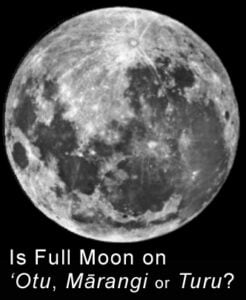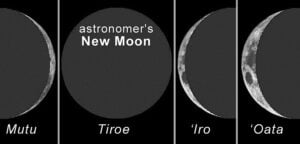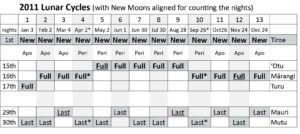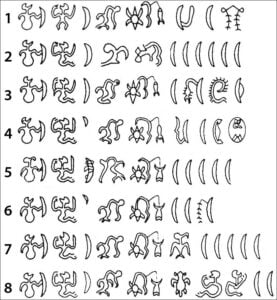Gerald McCormack, CINHT.
 The lunar month calendar of the Cook Islands is the arāpō or “path of the nights”, and the lunar year calendar is the nga tino marama.
The lunar month calendar of the Cook Islands is the arāpō or “path of the nights”, and the lunar year calendar is the nga tino marama.
The 13-month lunar year or annual calendar was difficult to keep synchronised with the seasons. It was abandoned soon after the missionaries brought the Gregorian calendar in the 1820s, which accurately predicted the seasons and required only a one day adjustment every four years.
The arāpō was not abandoned because it remained useful for predicting favourable and unfavourable nights for fishing and planting – and ghost (tūpāpaku) activity. When it is used as an oral calendar it was easy to adjust by direct observation of the moon.
As a written calendar it would seem an easy matter to synchronise the named-nights of the arāpō with a Gregorian calendar showing New Moon, First Quarter, Full Moon and Last Quarter. However, experience over the last twenty years, has shown that this is not easy and people have often noticed that the observed phase of the moon did not fall on the expected named-night of some printed arāpō.
Here we look at how the complexity of the lunar cycle challenges those who write an arāpō for the year ahead.
Motu – sometimes only
 Over the years I have collected numerous arāpō for different islands and their basic similarity is indicative of an ancient common origin. The arāpō shown as an example has been used often by Ministry of Agriculture.
Over the years I have collected numerous arāpō for different islands and their basic similarity is indicative of an ancient common origin. The arāpō shown as an example has been used often by Ministry of Agriculture.
Almost without exception the arāpō have 30 named nights starting with Tiroe and ending with Motu or Mutu. Astronomically the moon goes through its cycle in about 29.5 days, which means that during a year a repeating 30 night arāpō will become increasingly out of sync with the observed lunar events. For example, in a combined Gregorian and arāpō calendar of 1999 the observed New Moon was on the 16th January which was the 1st arāpō night of Tiroe, but by December, the observed New Moon was on ‘Akaoti Tangaroa the 26th arāpō night – five days ahead of Tiroe.
Lunar tables for 2011 lunar cycles show the number of nights from New Moon to New Moon as: 30, 30, 29, 30, 30, 29, 30, 29, 29, 30, 29, 30 and 29. To keep a 30 day arāpō aligned with the main lunar events throughout 2011 it is necessary to discard Motu/Mutu for the five cycles of 29 nights.
For a written arāpō the only way to know in advance when to use or discard Motu/Mutu is to look up an astronomical table to find the predicted nights for New Moon.
Curious treatment of New Moon
For the astronomer, New Moon is when none of the moon is illuminated by the sun and almost all arāpō have this as the first counted night even when saying it is not New Moon.
Some ‘arāpō’ phasesWhile some arāpō say Tiroe is New Moon, most say New Moon is two nights later on ‘Oata (3rd) and some have it on ‘Iro (2nd). In these latter cases it is not clear why the arāpō count starts ahead of the interpretation of New Moon. I have sometimes heard people talk about how the papa‘ā moon is ahead of the Māori moon and maybe this has something to do with this curious treatment of the New Moon in most arāpō.
Wandering Full Moon
With New and Full Moon being the most significant events, the lunar cycle is usually broken into two parts: waxing when the moon is increasing in the amount illuminated, and waning when the illuminated section is decreasing. In the arāpō waxing is anga raro, literally “in the west” and waning is anga runga, “in the east”.
Most arāpō show Full Moon as occurring on one night and most have this as Mārangi, the 16th night, while some show it as the 17th night of Turu. In searching for the correct night the astronomical data surprised me by showing that throughout a year, Full Moon wanders over three arāpō nights: 15th (‘Otu), 16th (Mārangi) and 17th (Turu). In the table of 2011 lunar cycles the nights of Full Moon are: 17th, 16th, 16th, 16th, 15th, 15th, 15th, 15th, 15th, 16th, 16th, 16th and 16th
Astronomically the main cause of this wandering Full Moon is the elliptical orbit of the moon. When the moon is closest to the earth (Perigee) the increased pull of the earth increases its orbital speed and if this occurs during a waxing moon the number of days of waxing is reduced. If it is most distant (Apogee) while waxing it travels slower and there are more days of waxing.
In the table, Perigee (P) and Apogee (A) are shown during waxing and we see that when there is a Perigee the Full Moon is usually on the 15th night (‘Otu) and when there is an Apogee the Full Moon is generally on the 16th (Mārangi) night and sometimes on the 17th night (Turu).
During the waning moon the effect is the opposite of the preceding waxing effect and over a given lunar cycle they cancel each other out so that the whole lunar cycle remains at around 29.5 days. The table shown here can be constructed for any particular years from data at https://www.timeanddate.com/moon/phases/cook-islands/rarotonga
This means that from a particular New Moon any attempt to predict the night of Full Moon using only an arāpō of immutable named nights is doomed to failure. The simplest solution is to be flexible and accept that the observed Full Moon can appear on ‘Otu, Mārangi or Turu.
In New Zealand, the Reverend Metera Aomarere of Otaki (70km northwest of Wellington) obtained a list of lunar nights from Mita te Tai and he recorded that it was adjusted to allow for the drift of Full Moon: “The fifteenth night is Ohua, but in certain months it is the 16th night, and sometimes it is the 17th night – that is, the condition of full moon is attained. If the moon does not become full until the 17th night, then the 15th, 16th, and 17th nights are all termed Ohua, and then the last three nights of the moon, Orongonui [28th], Maurea [29th], and Mutu [30th], are omitted, because a new moon has appeared.”((Best E. (1922) The Maori Division of Time. Dominiom Museum Monograph No.4. Wellington. p.23))
Best also reported an informant saying that the 10th night Huna could sometimes be removed, which shows that some New Zealand Māori made predictive adjustments to make Full Moon fall on a particular named night. The basis for the prediction of the days to Full Moon in a particular month is unknown, but the following case from Rapanui shows a possibility.
Rapanui lunar system
Soon after the arrival of the first Europeans, the people of Rapanui developed their own form of writing, called Rongorongo. The “Calendar sequence” shows a lunar cycle with lunar nights as right-facing crescents and an oval (Full Moon in line 4), and upward-pointing fish for waxing and downward for waning. What is intriguing is the repeated sequence of two people facing each. In 1990 linguist Jacques Guy suggested the first tōhunga was holding a measuring stick and the second was announcing the size of the moon as shown by the large or small crescent behind him.
When the moon is large, waxing will have fewer days because it is moving faster at Perigee, and a waxing named night needs to be removed to shift the named night for Full Moon forward so it will coincide with observed Full Moon. When it is smaller (at Apogee) they need to add a waxing night to keep the arāpō in sync with observed Full Moon. They would also have been adjusting for New Moon.
The question is: could they really measure the changing size of the moon with a stick? Astronomer Phil Evans, using a 10% size difference between Perigee and Apogee moons, calculated that if the Rapanui observers were five metres apart there would be a 5mm difference on the stick. He concluded that “it might have been possible but with difficulty”. Even if they overcame the difficulty, we will never know why it was worth so much effort – maybe, like scientists today, they just enjoyed trying to accurately predict the future.
Days are not nights
Lunar events on the web and in newspapers are given in terms of Gregorian days and this sometimes leads to a misalignment with an arāpō. For example, Full Moon on the 17th of May is at 1am, which for an arāpō is the night of the 16th of May. The easiest way to adjust for this misalignment is to move predawn lunar events to the previous Gregorian day. In the 2011 table used here to count the nights, the four events moved forward one night are underlined. Furthermore, moving a New Moon increased the count by one to the next Full Moon and Last night of the cycle, and these changes are marked with asterisks.
Conclusion
Aligning an arāpō of predetermined named nights with a Gregorian calendar is fraught with problems, because of the one day variation from New Moon to New Moon and the three day variation from New Moon to Full moon.
The simplest solution, as often used by the Ministry of Agriculture, is the side-by-side system. Print a conventional Gregorian twelve month calendar and using astronomical data for the Cook Islands time zone to show New Moon, First Quarter, Full Moon and Last Quarter. Such data is online at http://www.timeanddate.com/calendar/moonphases.html (set for Rarotonga).
Alongside print an arāpō calendar of 30 named nights showing the preferred named nights for New Moon and Full Moon and the Quarters, along with the predicted effects of every night on fishing and planting. In this way the user is responsible for sliding the arāpō back and forth to keep its main lunar events synchronised with those on the Gregorian calendar.
To merge an arāpō calendar into a Gregorian calendar is a hard work option. First you need to adjust the Gregorian lunar events by moving pre-dawn events forward a day. Then place the arāpō named nights in sequence, adding or removing names so that the next arāpō lunar event is aligned with the Gregorian lunar event.
Citation
McCormack, Gerald (2024) The Arāpō and the Troublesome Moon. Cook Islands Natural Heritage Trust.
First published CI News 2011, updated Jan 2024.















